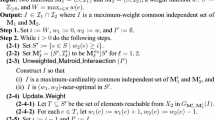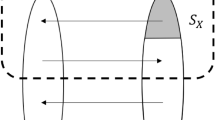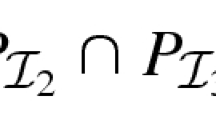Abstract
LetM 1 = (E, 91),M 2 = (E, 92) be two matroids over the same set of elementsE, and with families of independent sets 91, 92. A setI ∈ 91 ∩ 92 is said to be anintersection of the matroidsM 1,M 2. An important problem of combinatorial optimization is that of finding an optimal intersection ofM 1,M 2. In this paper three matroid intersection algorithms are presented. One algorithm computes an intersection containing a maximum number of elements. The other two algorithms compute intersections which are of maximum total weight, for a given weighting of the elements inE. One of these algorithms is “primal-dual”, being based on duality considerations of linear programming, and the other is “primal”. All three algorithms are based on the computation of an “augmenting sequence” of elements, a generalization of the notion of an augmenting path from network flow theory and matching theory. The running time of each algorithm is polynomial inm, the number of elements inE, and in the running times of subroutines for independence testing inM 1,M 2. The algorithms provide constructive proofs of various important theorems of matroid theory, such as the Matroid Intersection Duality Theorem and Edmonds' Matroid Polyhedral Intersection Theorem.
Similar content being viewed by others
References
J. Edmonds, “Minimum partition of a matroid into independent subsets”,Journal of Research of the National Bureau of Standards 69B (1965) 67–72.
J. Edmonds and D.R. Fulkerson, “Transversals and matroid partition”,Journal of Research of the National Bureau of Standards 69B (1965) 147–153.
J. Edmonds, “Submodular functions, matroids and certain polyhedra”,Combinatorial structures and their applications, proceedings of the Calgary international conference (Gordon and Breach, New York, 1970) pp. 67–87.
J. Edmonds, “Matroids and the greedy algorithm”,Mathematical Programming 1 (1971) 127–136.
S. Kundu and E.L. Lawler, “A matroid generalization of a theorem of Mendelsohn and Dulmage”,Discrete Mathematics 4 (1973) 159–163.
W.T. Tutte,Introduction to the theory of matroids (American Elsevier, New York, 1971).
D.J.A. Welsh, “On matroid theorems of Edmonds and Rado”,Journal of the London Mathematical Society 45 (1970) 251–256.
Additional references
M. Aigner and T.A. Dowling, “Matching theory for combinatorial geometries”,Transactions of the American Mathematical Society 158 (1971) 231–245.
M. Iri and N. Tomizawa, “An algorithm for finding an optimal ‘independent assignment”, University of Tokyo, unpublished.
Stein Krogdahl, “A combinatorial proof for Lawler's Matroid Intersection Algorithm”, to appear.
Author information
Authors and Affiliations
Additional information
Research sponsored by the Air Force Office of Scientific Research Grant 71-2076.
Rights and permissions
About this article
Cite this article
Lawler, E.L. Matroid intersection algorithms. Mathematical Programming 9, 31–56 (1975). https://doi.org/10.1007/BF01681329
Received:
Revised:
Issue Date:
DOI: https://doi.org/10.1007/BF01681329




